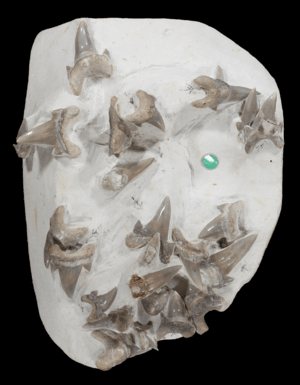Dwardius facts for kids
Quick facts for kids Dwardius |
|
|---|---|
 |
|
| Associated teeth of D. woodwardi (NHMUK PV OR 39053) from Cretaceous chalk in Kent, England | |
| Scientific classification |
|
| Kingdom: | Animalia |
| Phylum: | Chordata |
| Class: | Chondrichthyes |
| Order: | Lamniformes |
| Family: | †Cardabiodontidae |
| Genus: | †Dwardius Siverson, 1999 |
Dwardius was a type of ancient shark that is now extinct. This means it no longer lives on Earth. These sharks swam in the oceans during the Cretaceous period. This was a very long time ago, when dinosaurs also roamed the Earth!
Fossils of Dwardius have been found in different parts of the world. These places include Australia, England, France, and India. Finding fossils in these areas helps scientists learn where these sharks lived.
Meet Dwardius: An Ancient Shark
Dwardius belongs to a group of sharks called cardabiodontid sharks. These were large, powerful sharks that lived in the seas. Scientists study their fossilized teeth to learn about them. The teeth can tell us how big they were and what they might have eaten.
Discovering Dwardius
The first time Dwardius was officially named was in 1999. A scientist named Mikael Siverson described it. But the story of Dwardius started even earlier. In 1977, another scientist, J. Hermann, had described a shark species called Cretalamna woodwardi. Mikael Siverson later realized this shark was special enough to have its own new group, or genus, which he named Dwardius.
Different Kinds of Dwardius
Scientists have found a few different types, or species, of Dwardius. Each species has its own unique name.
- Dwardius woodwardi: This was the first species to be described. It was originally named by J. Hermann in 1977.
- Dwardius siversoni: This species was found in France in 2000. It was named by V.I. Zhelezko. The name siversoni honors Mikael Siverson, who first described the Dwardius genus.
- Dwardius sudindicus: This species was discovered in India in 2011. It was described by a team of scientists including Charlie J. Underwood and Anjali Goswami.
Studying these different species helps us understand how Dwardius sharks changed over time. It also shows how they spread across ancient oceans.

